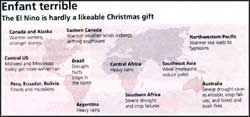Weathering El Nino
 ALFRED Russel Wallace, co-originator of the modern theory of evolution of life; Paul Gauguin's famous paintings of Tahitian life; the Guam island massacre of POWs by the Japanese during World War II -- these are a few images that flash upon the mind when one thinks of the tropical Pacific off the eastern coast of Australia.
ALFRED Russel Wallace, co-originator of the modern theory of evolution of life; Paul Gauguin's famous paintings of Tahitian life; the Guam island massacre of POWs by the Japanese during World War II -- these are a few images that flash upon the mind when one thinks of the tropical Pacific off the eastern coast of Australia.
Of late, this little known part of our planet has grabbed world attention for the notorious El Nino, an enigmatic warming of ocean waters in the tropical Pacific that has played havoc with global climate, bringing misery to millions of farmers. The 1982 floods in Peru, which caused losses worth US $2 billion, the failure of the Indian monsoon in 1987, and southern Africa's worst drought of the century 3 years ago, all have been linked to this phenomenon.
And now, once again, El Nino seems imminent. The US National Weather Service has already warned of El Nino stirrings and agricultural planners in southern Africa and other countries are advising their farmers on which crops to plant to lessen the losses.
The extremely complex nature of El Nino has frustrated scientists' attempt to predict the cause and timing of this Pacific devil. But a few recent studies have offered new insights into El Nino's apparently inscrutable character.
The first, and perhaps the most significant study, links El Nino with drought in southern Africa. Climate researchers Mark Cane and Gidon Eshel of Columbia University's Lamont-Doherty Earth Observatory and Roger W Buckland, an agricultural economist with the 10-nation Southern African Development Community, analysed the occurrences of El Nino between 1970 and 1993 and found that they went hand in hand with sharp declines in both rainfall and corn harvests in Zimbabwe. Experts believe that the findings could be used to establish an early-warning system of drought.
El Nino has also been implicated in the as-yet-unsettled case of global warming. At least 3 studies of long-term trends in global climate identify El Nino as a key orchestrator of climate change.
In one of the models, Arun Kumar and his colleagues at the National Meteorological Center (NMC) in Maryland investigated the effects of global patterns of sea-surface temperatures over the past 4 decades. They found that the model produced a warming on land in much the same places and during the same seasons as the record global warming observed in the '80s, suggesting that warm stirrings in the tropical Pacific were responsible. And sure enough, since 1976 there have been 4 El Ninos and only 1 La Nina, the former's cold counterpart, which usually alternates with the warm current.
NMC's findings have found support in 2 other studies, one by Nicholas Graham of the Scripps Research Institute and the other by Ngar-Cheung Lau and Mary Jo Nath of the Geophysical Fluid Dynamics Laboratory in Princeton, New Jersey. They looked at a cropped up picture of the effects of temperature changes in individual oceans. Both groups found that model runs that included the entire tropical ocean or just the tropical Pacific most closely simulated what happened globally in the real world.
Graham argues that Pacific warming leads to increasing evaporation at the sea surface, warming the atmosphere. The warming of the tropical atmosphere triggers signals whose ripples are felt by climates of distant places.
But what causes the tropical Pacific to warm up is still a mystery. Graham suspects the greenhouse effect. Climate models that reckon the increase in greenhouse gases, he says, also point to warmed-up tropics.
A computer model developed by Mojib Latif of the Max Planck Institute for Meteorology in Hamburg, Germany, and Tim P Barnett of Scripps Research Institute, however, has identified a regular oscillation in the winds and currents of the North Pacific Ocean that could be masquerading temporarily as greenhouse warming. This only goes to show that no matter how persuasive these findings might be, the uncertainties about weather will remain.
Related Content
- Warmer winters 2024: Himalayas will bear maximum brunt of climate change
- Seasonal attribution report: an analysis of how climate change boosted temperatures worldwide between December 2023 and February 2024
- Global report on food crises 2023 mid-year update
- Global annual to decadal climate update (Target years: 2023-2027)
- Planning for an uncertain future: strengthening the resilience of Indonesian water utilities
- 2019 Climate & Crop Report
